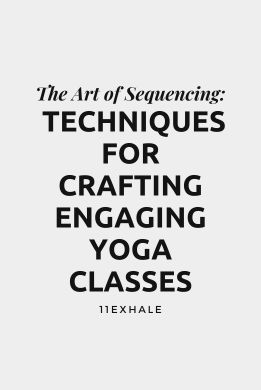Crafting a yoga sequence is an art form—one that I have refined over years of practice, teaching, and learning from both my experiences and my students. As the heart of any yoga class, a well-designed sequence not only guides students through a physical journey but also creates a narrative that engages the mind and spirit. Today, I’m excited to share some of the insights and techniques I’ve developed at 11Exhale to help you create thoughtful and effective yoga sequences.
Personal Journey into Sequencing
My own journey with sequencing began in the early days of my teaching career, fresh from completing my first yoga teacher training. I remember the initial struggle to balance the flow of poses with the energetic and emotional needs of my students. It was during a retreat in Costa Rica, surrounded by veteran yogis, where I truly understood the importance of intentional sequencing. This experience taught me that every pose and transition is a building block in the architecture of a class.
Understanding the Foundation
A solid sequence is rooted in an understanding of anatomy and the purpose of each class. Whether you’re aiming to energize, relax, or deepen practice, every sequence should support this intention. Start with a clear goal: What do you want your students to achieve by the end of the class? This intention will guide the pace, the choice of poses, and the transitions between them.
Balancing the Elements
One of my key strategies is balancing the physical and energetic elements of a class. This involves a mix of dynamic movements to build heat and strength, and static poses for stability and grounding. For instance, a class aimed at releasing stress may start with gentle stretches, peak with challenging poses to release tension, and conclude with soothing restorative poses. Each sequence should feel like a journey that has a beginning, middle, and end.
The Role of Creativity and Intuition
Creativity plays a crucial role in sequencing. Over the years, I’ve learned to incorporate thematic elements that resonate with my students—like seasonal changes or philosophical themes from yoga texts. This not only enriches the practice but also connects the physical practice to deeper reflections.
Intuition also guides my sequencing. Sometimes, despite planning, you need to read the room and adjust on the fly. This responsiveness to the energy of the class is something that comes with experience and a deep connection to your students.
Continual Learning and Feedback
Mastering sequencing is an ongoing process. I constantly seek feedback from my students and fellow teachers. This feedback, combined with regular self-reflection and continuing education, helps refine my sequences and teaching methods.
Sharing the Knowledge
In our teacher training programs at 11Exhale, we emphasize the importance of sequencing in creating impactful classes. I encourage all yoga teachers to view each class as an opportunity to tell a story—a narrative crafted through sequences that not only challenge the body but also inspire and heal.
Embrace the art of sequencing as a dynamic and ever-evolving aspect of your teaching journey. Let it be guided by knowledge, creativity, and the unique energies of your students.
With love and flexibility,
Julianne Arce
